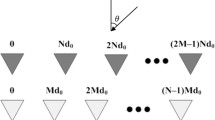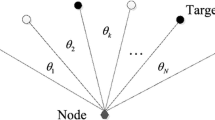Abstract
In this study we propose a novel sparse antenna array and suitable beamforming algorithm in order to decrease the number of antennas in large-scale antenna systems (LSASs) and achieving the performance of a dense antenna array. To design a sparse array we use the familiar array geometry that is called co-prime sensor array (CSA), which has been recently introduced as an effective sparse configuration in direction of arrival (DOA) estimation and beamforming applications. The prototype CSA can achieve narrow beam widths using far fewer sensors than a fully populated uniform linear array (Full ULA), but at a cost of the appearance of grating lobes. Grating lobe manifests itself as leakage in the spectral domain, distorting other weak spectral responses. To mitigate this issue, we use a new processing method based on digital beamforming at sub-array level. Moreover, we developed a novel sparse array geometry, so-called Extended Optimum CSA (EOCSA), for DOA estimation of received signal. The EOCSA would be very useful in many practical applications where the number of sensors is limited. The performance of the proposed beamfoming method in EOCSA with \(N=O(N_1+N_2)\) sensors is compared to a Full ULA with \(M=O(N_1N_2)\) physical sensors. The results illustrate the EOSCA ability to reaches the same power pattern of a Full ULA using relatively few sensors. Analytical and simulated results demonstrate that the power pattern obtained by the proposed beamforming processor in the EOCSA, in terms of side lobe level (SSL), peak side lobe level (PSL) and integrated side lobe level (ISL), is better than the previous arrays and processors.


















Similar content being viewed by others
References
Adhikari, K., Buck, J. R., & Wage, K. E. (2014). Extending coprime sensor arrays to achieve the peak side lobe height of a full uniform linear array. EURASIP Journal on Advances in Signal Processing, 1, 148.
Alawsh, S. A., & Muqaibel, A. H. (2018). Multi-level prime array for sparse sampling. IET Signal Processing, 12(6), 688–699.
Aumann, H. M. (2010). A pattern synthesis technique for multiplicative arrays. In PIERS proceedings, Cambridge, USA (pp. 864–867).
Baxter, W., Nosrati, H., & Aboutanios, E. (2019). Coprime beamforming: Fast estimation of more sources than sensors. IET Radar, Sonar & Navigation, 13(11), 1956–1962.
Berman, A., & Clay, C. (1957). Theory of time-averaged-product arrays. The Journal of the Acoustical Society of America, 29(7), 805–812.
Chavali, V., & Wage, K. E. (2017). Comparison of multiplicative and min processors for coprime and nested geometries using the Elba island data set. The Journal of the Acoustical Society of America, 141(5), 3843–3843.
Dassios, I., Fountoulakis, K., & Gondzio, J. (2015). A preconditioner for a primal-dual Newton conjugate gradient method for compressed sensing problems. SIAM Journal on Scientific Computing, 37(6), A2783–A2812.
Dassios, I., Tzounas, G., & Milano, F. (2020). Participation factors for singular systems of differential equations. Circuits, Systems, and Signal Processing, 39(1), 83–110.
Dassios, I. K., & Szajowski, K. J. (2016). Bayesian optimal control for a non-autonomous stochastic discrete time system. Applied Mathematics and Computation, 274, 556–564.
Davies, D., & Ward, C. (1980). Low side lobe patterns from thinned arrays using multiplicative processing. IEE Proceedings F (Communications, Radar and Signal Processing), 127(1), 9–15.
Di Martino, G., & Iodice, A. (2016). Passive beamforming with coprime arrays. IET Radar, Sonar & Navigation, 11(6), 964–971.
Ingle, V., Kogon, S., & Manolakis, D. (2005). Statisical and adaptive signal processing. Artech.
Kasilingam, D., & Shah, J. (2017). Antenna beamforming using multiplicative array processing. In 2017 IEEE international symposium on antennas and propagation & USNC/URSI national radio science meeting (pp 1387–1388).
Liu, Y., & Buck, J. R. (2015). Detecting gaussian signals in the presence of interferers using the coprime sensor arrays with the min processor. In IEEE (pp. 370–374).
Liu, Y., & Buck, J. R. (2016). Spatial spectral estimation using a coprime sensor array with the min processor. In Sensor array and multichannel signal processing workshop (SAM) (pp. 1–5). IEEE.
Liu, Y., & Buck, J. R. (2018). Gaussian source detection and spatial spectral estimation using a coprime sensor array with the min processor. IEEE Transactions on Signal Processing, 66(1), 186–199.
Liu, Y., Buck, J. R., & Bautista, R. (2016). Spatial power spectral estimation using coprime sensor array with the min processor. The Journal of the Acoustical Society of America, 139(4), 2109–2110.
Moffet, A. (1968). Minimum-redundancy linear arrays. IEEE Transactions on Antennas and Propagation, 16(2), 172–175.
Moghadam, G. S., & Shirazi, A. A. B. (2018a). Direction of arrival estimation with co-prime arrays based on multiplicative beamforming. In 2018 9th International symposium on telecommunications (IST) (pp. 501–506).
Moghadam, G. S., & Shirazi, A. A. B. (2018b). A novel side lobe reduction algorithm based on null synthesis method under mainlobe perturbation minimization constraint for co-prime sensor array. In 2019 IEEE conference on knowledge based engineering and innovation (KBEI) (pp. 327–331).
Moghadam, G. S., & Shirazi, A. A. B. (2019a). Direction of arrival estimation with extended optimum co-prime sensor array. In 2019 IEEE Iranian conference on radar and surveillance systems (pp. 1–6).
Moghadam, G. S., & Shirazi, A. B. (2019b). Novel method for digital beamforming in co-prime sensor arrays using product and min processors. IET Signal Process, 13(6), 614–623.
Moghadam, G. S., & Shirazi, A. B. (2019c). Passive beamforming in co-prime sensor arrays using NSCB method under original pattern perturbations minimization. Multidimensional Systems and Signal Processing, 31, 527–547.
Pal, P., & Vaidyanathan, P. (2010). Nested arrays: A novel approach to array processing with enhanced degrees of freedom. IEEE Transactions on Signal Processing, 58(8), 4167–4181.
Rawnaque, F. S., & Buck, J. R. (2017). Comparing the effect of aperture extension on the peak side lobe level of sparse arrays. The Journal of the Acoustical Society of America, 142(5), EL467–EL472.
Tuncer, T. E., Yasar, T. K., & Friedlander, B. (2009). Narrowband and wideband DOA estimation for uniform and nonuniform linear arrays (pp. 125–160). Elsevier.
Vaidyanathan, P. P., & Pal, P. (2011). Sparse sensing with co-prime samplers and arrays. IEEE Transactions on Signal Processing, 59(2), 573–586.
Van Trees, H. L. (2002). Detection, estimation, and modulation theory, part 4, optimum array processing. Wiley.
Welsby, V., & Tucker, D. (1959). Multiplicative receiving arrays. Journal of the British Institution of Radio Engineers, 19(6), 369–382.
Author information
Authors and Affiliations
Corresponding author
Additional information
Publisher's Note
Springer Nature remains neutral with regard to jurisdictional claims in published maps and institutional affiliations.
Rights and permissions
About this article
Cite this article
Moghadam, G.S., Shirazi, A.B. Direction of arrival (DOA) estimation with extended optimum co-prime sensor array (EOCSA). Multidim Syst Sign Process 33, 17–37 (2022). https://doi.org/10.1007/s11045-021-00787-8
Received:
Revised:
Accepted:
Published:
Issue Date:
DOI: https://doi.org/10.1007/s11045-021-00787-8




